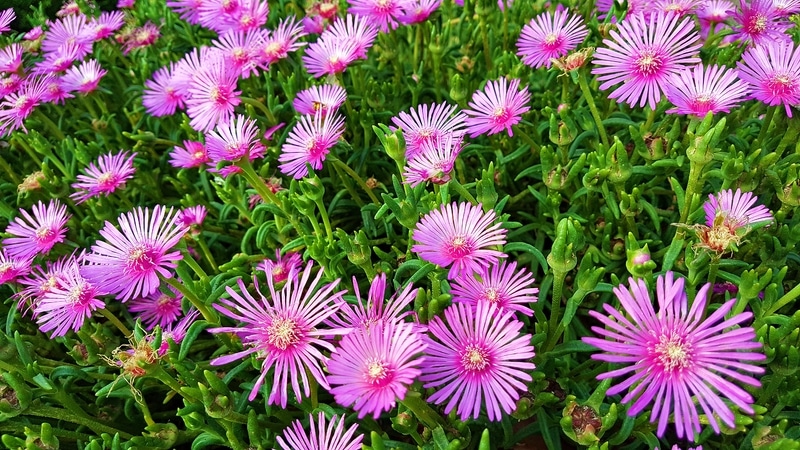Want to know how to propagate ice plants? Ice plants are hardy succulents that are native to South Africa, so they thrive best in warm and dry climates.
Many people love ice plants because of their short and spiky leaves and the flowers that bloom during summer and fall. The flowers come in different colors, such as bright orange, pink, purple, white, or bright red.

How to Propagate Ice Plants
Ice plants look better when they’re planted together, so homeowners propagate their ice plants and plant them next to each other. There are two ways you can propagate these plants: seeds or cuttings. Here’s how:
Seeds
You can grow ice plants from seeds by sprinkling them on a well-drained potting mix. Don’t cover your seeds as it needs light to germinate. Where you place your seeds depends on your USDA hardiness zone.
If you belong to zones 9b to 11, you can keep your seeds outside. On the other hand, zones 9a and below should keep their seeds inside, but make sure you provide them with enough light.
Cuttings
Another way to propagate ice plants through cuttings. You can cut your plants during the spring, summer, or fall seasons.
Cut a section of the stem and give it time to callous before inserting it in well-aerated soil. Only water the cuttings when the soil is completely dry.
When cutting the stems, make sure to use sharp gardening shears or scissors. Additionally, sterilize your shears before cutting to avoid the spreading of infectious diseases that could affect your plants.
How to Take Care of Your Ice Plants
Now that you know how to propagate your ice plants, the next thing you should know is how to keep them alive and healthy. Here are some of the factors you should keep in mind:
Temperature
Even though they’re called ice plants, these plants cannot survive in cold temperatures. They prefer to be planted in temperatures between 25 to 30 degrees Fahrenheit, which is usually located in zones 9b to 11b.
If you live in areas with lower temperatures, consider growing your plants in a greenhouse or a container. If you choose the latter, be sure to bring your plants inside when the temperature drops.
Lighting
Ice plants love the sunlight, so it’s best to place them under direct sunlight for most of the day. If this isn’t possible, a partial shade is the next best thing. If you’re growing your ice plants indoors, place them near a bright window to expose them to sunlight.
Watering
Just like other succulents, you don’t need to water ice plants frequently because it could lead to root rot. Only water your plants when the soil is completely dried out. Stick your finger into the soil (about two to three inches) to see whether your plant needs watering or not.
When you do water your ice plants, make sure that the soil is completely soaked before you stop watering. If you planted your plants in a container, water them until you can see the water drain from the pot.
Soil
The amount of water you give your plants go hand in hand with the soil you use. As mentioned, a well-draining potting mix is the best choice because the longer water stays in the soil, and your plant will be more susceptible to root rot.
You can opt to use a potting mix specially made for cacti or succulents. These potting mixes usually dry out faster than regular soil.
You can also make your own potting mix by making your soil more porous. Add a mixture of sand and perlite or pumice.
Why Should You Grow Ice Plants in a Mini Greenhouse?
There are several benefits to growing your plants inside a mini greenhouse. Here are some of them:
Protect your plants from pests and diseases
Mealybugs and scales are some of the common pests that infest ice plants. As for diseases, downy mildew affects these plants the most. If you grow your ice plants inside a mini greenhouse, this lowers the risk of pest infestation and infections that could come from neighboring plants.
Great for people with limited space
A mini greenhouse is ideal for people with limited gardening space. Small greenhouses have a standard size of six feet, allowing you to place them on your balconies, patios, and backyards. There are smaller ones available as well and you can even place them on tabletops.
Create a microclimate for your plants
If you live in colder areas, you can use a greenhouse to grow warm-weather plants like ice plants. With the help of insulation, ventilation, and heating systems, you can create your own microclimate regardless of the weather outside. You don’t have to wait for the weather to warm to grow crops and other plants.
Shield your plants from extreme weather
Snow, frost, and ice can kill even the most cold-tolerant plants. Placing your plants inside a mini greenhouse shields them from extreme weather conditions. You can keep your plants healthy in a mini greenhouse and once the weather becomes friendly enough you can transplant your plants outside.
Final Thoughts on How to Propagate Ice Plants
Knowing how to propagate ice plants ensures that you’ll be able to enjoy beautiful and colorful blooms throughout the summer and fall season. Make sure to keep these tips in mind so you can successfully propagate and grow ice plants.
